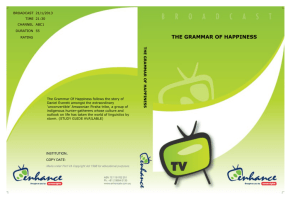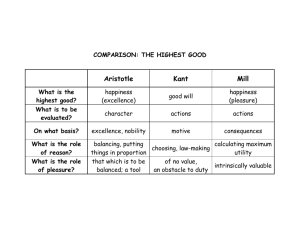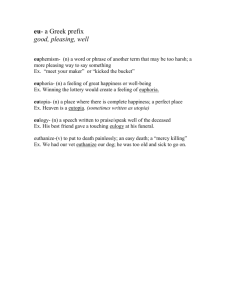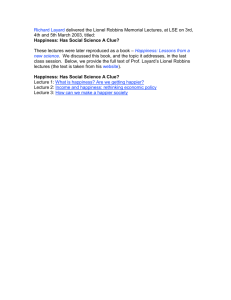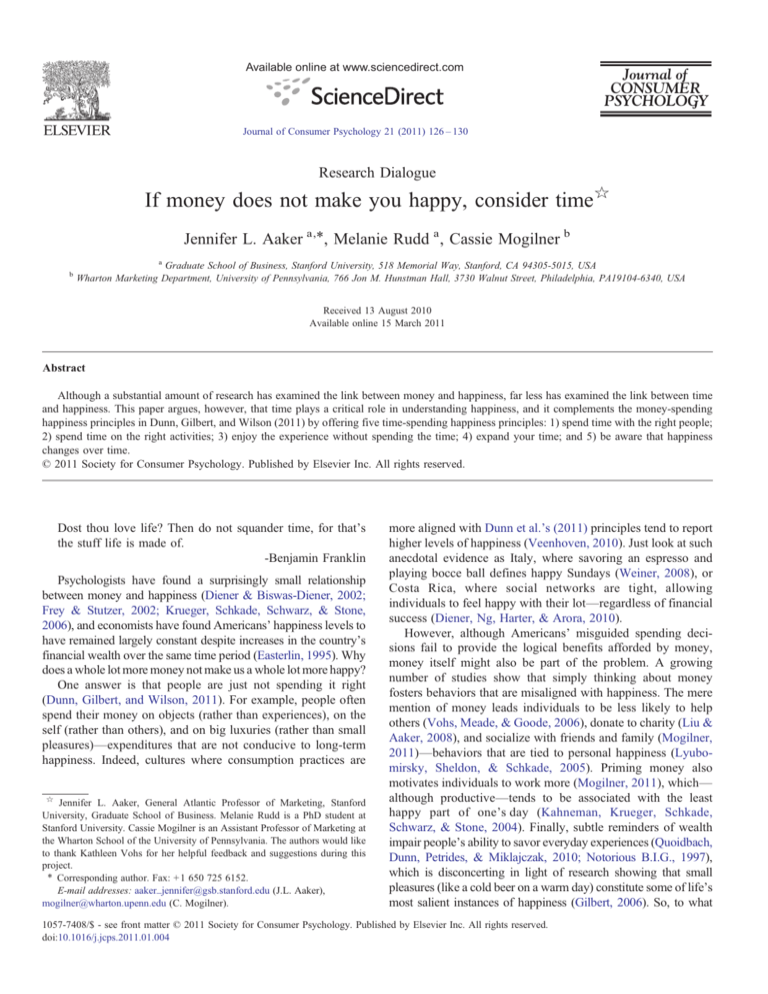
Available online at www.sciencedirect.com
Journal of
CONSUMER
PSYCHOLOGY
Journal of Consumer Psychology 21 (2011) 126 – 130
Research Dialogue
If money does not make you happy, consider time☆
Jennifer L. Aaker a,⁎, Melanie Rudd a , Cassie Mogilner b
a
b
Graduate School of Business, Stanford University, 518 Memorial Way, Stanford, CA 94305-5015, USA
Wharton Marketing Department, University of Pennsylvania, 766 Jon M. Hunstman Hall, 3730 Walnut Street, Philadelphia, PA19104-6340, USA
Received 13 August 2010
Available online 15 March 2011
Abstract
Although a substantial amount of research has examined the link between money and happiness, far less has examined the link between time
and happiness. This paper argues, however, that time plays a critical role in understanding happiness, and it complements the money-spending
happiness principles in Dunn, Gilbert, and Wilson (2011) by offering five time-spending happiness principles: 1) spend time with the right people;
2) spend time on the right activities; 3) enjoy the experience without spending the time; 4) expand your time; and 5) be aware that happiness
changes over time.
© 2011 Society for Consumer Psychology. Published by Elsevier Inc. All rights reserved.
Dost thou love life? Then do not squander time, for that's
the stuff life is made of.
-Benjamin Franklin
Psychologists have found a surprisingly small relationship
between money and happiness (Diener & Biswas-Diener, 2002;
Frey & Stutzer, 2002; Krueger, Schkade, Schwarz, & Stone,
2006), and economists have found Americans’ happiness levels to
have remained largely constant despite increases in the country's
financial wealth over the same time period (Easterlin, 1995). Why
does a whole lot more money not make us a whole lot more happy?
One answer is that people are just not spending it right
(Dunn, Gilbert, and Wilson, 2011). For example, people often
spend their money on objects (rather than experiences), on the
self (rather than others), and on big luxuries (rather than small
pleasures)—expenditures that are not conducive to long-term
happiness. Indeed, cultures where consumption practices are
☆
Jennifer L. Aaker, General Atlantic Professor of Marketing, Stanford
University, Graduate School of Business. Melanie Rudd is a PhD student at
Stanford University. Cassie Mogilner is an Assistant Professor of Marketing at
the Wharton School of the University of Pennsylvania. The authors would like
to thank Kathleen Vohs for her helpful feedback and suggestions during this
project.
⁎ Corresponding author. Fax: +1 650 725 6152.
E-mail addresses: aaker_jennifer@gsb.stanford.edu (J.L. Aaker),
mogilner@wharton.upenn.edu (C. Mogilner).
more aligned with Dunn et al.'s (2011) principles tend to report
higher levels of happiness (Veenhoven, 2010). Just look at such
anecdotal evidence as Italy, where savoring an espresso and
playing bocce ball defines happy Sundays (Weiner, 2008), or
Costa Rica, where social networks are tight, allowing
individuals to feel happy with their lot—regardless of financial
success (Diener, Ng, Harter, & Arora, 2010).
However, although Americans’ misguided spending decisions fail to provide the logical benefits afforded by money,
money itself might also be part of the problem. A growing
number of studies show that simply thinking about money
fosters behaviors that are misaligned with happiness. The mere
mention of money leads individuals to be less likely to help
others (Vohs, Meade, & Goode, 2006), donate to charity (Liu &
Aaker, 2008), and socialize with friends and family (Mogilner,
2011)—behaviors that are tied to personal happiness (Lyubomirsky, Sheldon, & Schkade, 2005). Priming money also
motivates individuals to work more (Mogilner, 2011), which—
although productive—tends to be associated with the least
happy part of one's day (Kahneman, Krueger, Schkade,
Schwarz, & Stone, 2004). Finally, subtle reminders of wealth
impair people's ability to savor everyday experiences (Quoidbach,
Dunn, Petrides, & Miklajczak, 2010; Notorious B.I.G., 1997),
which is disconcerting in light of research showing that small
pleasures (like a cold beer on a warm day) constitute some of life's
most salient instances of happiness (Gilbert, 2006). So, to what
1057-7408/$ - see front matter © 2011 Society for Consumer Psychology. Published by Elsevier Inc. All rights reserved.
doi:10.1016/j.jcps.2011.01.004
J.L. Aaker et al. / Journal of Consumer Psychology 21 (2011) 126–130
degree might a focus on money be obfuscating our vision of what
really makes us happy? Although correcting how we spend our
money is likely to lead us closer to the holy grail of happiness, we
might get even further with a consideration of our other principle
resource—time.
Why might a focus on time move us closer to the elusive goal
of improving happiness? One reason is because time, relative to
money, tends to be laden with personal meaning (Mogilner &
Aaker, 2009; Reed, Aquino, & Levy, 2007). Another reason is
that time fosters interpersonal connection (Mogilner, 2011).
Since both personal meaning and social connection are critical
to happiness (e.g., Cacioppo, et al. 2008; Ryan & Deci, 2001), a
consideration of time (specifically, how individuals spend their
time) may be important in our effort to solve the happiness
puzzle.
One caveat, however. Time versus money is somewhat of a
false dichotomy. Although both are resources that people must
decide how to spend and save, a clean comparison is difficult
because of the many confounds between the two constructs and
the psychologically distinct characteristics that impact each
one's allocation (e.g., Leclerc, Schmitt, & Dubé, 1995; Okada
& Hoch, 2004; Saini & Monga, 2008; Zauberman & Lynch,
2005). Therefore, we are not looking to directly compare time
and money here. Rather, we are examining ways to spend the
resource of time that would increase personal meaning and
social connection.
Thus, with a goal to complement the eight principles of
happiness-maximizing ways to spend money (Dunn et al., 2011),
this paper offers five principles for happiness-maximizing ways to
spend time.
Principle 1: Spend your time with the right people
There is a clear relationship between happiness and the
amount of satisfaction a person derives from a leisure
experience (Van Praag, Frijters, & Ferrer-i-Carbonell, 2003),
and social leisure activities contribute more to happiness than
solitary ones (Reyes-Garcia et al., 2009). Furthermore, people
who frequently engage in social activities experience higher
levels of happiness than people who participate in social
activities less often (Lloyd & Auld, 2002), and being with
others typically improves the quality of an experience (whereas
being alone makes most people lonely, sad, or both;
Csikszentmihalyi & Larson, 1984; Lewinsohn, Sullivan, &
Grosscup, 1982).
However, it is not only whether you spend your time with
others that influences your happiness, but also who you spend
your time with. Interaction partners associated with the greatest
happiness levels include friends, family, and significant others,
whereas bosses and co-workers tend to be associated with the
least happiness (Kahneman et al., 2004). Why, then, do we
continue to spend so much time with people who are associated
with lower levels of happiness? One answer is money. The
culprit once again rears its ugly head, encouraging us to spend
time in ways that are suboptimal (i.e., at work!). For most
people, work subsumes the majority of one's waking hours,
which raises the question: Is there a way to reframe relation-
127
ships and workplace goals such that colleagues become friends
and time spent at work becomes happier?
Indeed, two of the biggest predictors of people's general
happiness are whether they have a “best friend” at work (Rath &
Harter, 2010) and whether they like their boss (Crabtree, 2004).
Greater attention, therefore, needs to be paid to how such
workplace relationships form and grow. For example, workplace friendships progress through three transitions: co-workerto-friend, friend-to-close friend, and close-friend-to-almostbest-friend (Sias & Cahill, 1998). With each transition, the
communication between the individuals becomes more intimate, less cautious, and less superficial, which is important
given that more substantive conversations (and less small talk)
over the course of one's day is related to greater happiness
(Mehl, Vazire, Holleran, & Clark, 2010). As the quality of
workplace friendships increase, so does workplace happiness
(Winstead, Derlega, Montgomery, & Pilkington, 1995) and
productivity (Rath & Harter, 2010). Thankfully, certain
behavioral norms in the workplace can help foster these
friendships. For example, social lubricants, such as smiling,
help ease the migration across transitions (e.g., Kraut &
Johnston, 1979; Laird, 1984). So, once you've warmed up
your friend at work with a smile, you might consider initiating a
substantive (non-work related) conversation.
Principle 2: Spend your time on the right activities
Investigations into people's activities and emotions over the
course of their day revealed that socially connecting activities
(such as hanging out with friends and family) comprise the
happiest parts of the day, whereas working and commuting
make for particularly unhappy portions of the day (Csikszentmihalyi & Hunter, 2003; Kahneman et al., 2004). However, for
some, spending time with one's mother will likely produce
more anxiety and frustration than happiness,1 and for others
whose professions are particularly fulfilling, an hour at work
could be as rewarding as an hour socializing (Mogilner, Aaker,
& Vohs, 2011).
Perhaps for an individual to determine the happiest way to
spend his or her own time, it would be useful to consider the
following questions: How you are spending your time right
now? And what are the chances that the value of that temporal
expenditure will increase over time (like any good investment)?
In other words, to what degree is the content of that experience
“evergreen”—perennially fresh and enduring? Dunn et al.
(2011) address these questions by honing in on the power of
memories, assessing the degree to which the current experience
will remain sticky over the long run. Indeed, sticky experiences
are more valuable because they temporally extend the pleasure
of a single moment.
In addition, when deciding how to spend the next hour,
simply asking yourself the question, “Will what I do right now
become more valuable over time?” could increase your
likelihood to behave in ways that more clearly map onto what
1
This is not the case with any of the authors of this paper.
128
J.L. Aaker et al. / Journal of Consumer Psychology 21 (2011) 126–130
will really make you happy. Note that this question is slightly
different than asking, “What is better for me in the long run?”
or, “What will lead to greater long-term happiness?” — two
questions that often cause a tinge of guilt or moral dilemma.
This particular question focuses less on perceived trade-offs
between short and long-term happiness, and more on maximizing the value of the present moment. For example, we know that
volunteering makes people happy (Borgonovi, 2008; Thoits &
Hewitt, 2001). Unfortunately, people tend to “under-help”—
possibly because the idea of helping others as a way to achieve
happiness is not salient, whereas the pressing, logistical
concerns of one's daily schedule are hard to not think about
(Trope & Liberman, 2003). Considering how valuable the next
hour will be (beyond that hour) might increase the chance that
one engages in happy (prosocial) behaviors.
Principle 3: Enjoy the experience without spending the time
Research in the field of neuroscience has shown that the part
of the brain responsible for feeling pleasure, the mesolimbic
dopamine system, can be activated when merely thinking about
something pleasurable, such as drinking one's favorite brand of
beer (McClure et al., 2004) or driving one's favorite type of
sports car (Erk, Spitzer, Wunderlich, Galley, & Walter, 2002).
In fact, the brain sometimes enjoys anticipating a reward more
than receiving the reward (Loewenstein, 1987; Berns, McClure,
Pagnoni, & Montague, 2001). Thus, the pleasure derived from
window shopping for a dress may exceed the pleasure from
actually acquiring the dress. Similarly, reading guidebooks to
plan for a big vacation, anticipating the pleasure associated with
the food and activities on the vacation, and then cancelling or
postponing the vacation until next year could actually give you
more pleasure than going on the vacation as originally planned
(particularly since the logistical stresses of finding a cat-sitter,
getting the necessary vaccines, and taking the days off from
work mount as the vacation draws near; Liberman & Trope,
1998; Mogilner, Aaker, & Pennington, 2008). In short, this
research suggests that we might be just as well off, or even
better off, if we imagine experiences, but not have them.
Principle 4: Expand your time
Unlike money, time is inherently scarce. No one gets more
than 24 hours per day, rendering time an oft-desired resource. In
fact there is a bi-directional relationship between the scarcity of
time and its value: not only does having little time make it feel
more valuable, but when time is more valuable, it is perceived
as more scarce (DeVoe & Pfeffer, forthcoming).
To increase happiness, many advocate focusing on “the here
and now” (e.g., Dunn et al., 2011). Why? One possible benefit
of being present-focused is that thinking about the present
moment (vs. the future) slows down the perceived passage of
time, allowing people to feel less rushed and hurried (Rudd &
Aaker, 2011). Similar effects accrue when individuals simply
breathe more deeply. In one study, subjects who were instructed
to take long and slow breaths (vs. short and quick ones) for 5
minutes not only felt there was more time available to get things
done, but also perceived their day to be longer (Rudd & Aaker,
2011). People can also expand their time by spending time
doing something meaningful, like helping another (Chance,
Mogilner, & Norton, 2011). Even though feeling timeconstrained makes people less likely to take the time to help
someone, spending time on someone else (vs. on oneself and vs.
getting time) subsequently makes people feel like they have
more spare time and that their future is more expansive.
In general, having a sense of control over one's life makes a
person happier (Duncan-Myers & Huebner, 2000; Perlmutter &
Monty, 1977; Veenhoven, 1984; Peterson, 1999), less depressed (Abramson, Metalsky, & Alloy, 1989), and physically
healthier (Pulkkinen, Kokkonen, & Mäkiaho, 1998; Marmot,
2004). Therefore, having (or perceiving) greater control over
how time is spent should have similarly positive effects. For
instance, freely chosen activities increase happiness, whereas
obligatory activities lower it (Csikszentmihalyi & Hunter,
2003). Furthermore, having spare time and perceiving control
over how to spend that time (i.e. discretionary time) has been
shown to have a strong and consistent effect on life satisfaction
and happiness, even controlling for the actual amount of free
time one has (Eriksson, Rice, & Goodin, 2007; Goodin, Rice,
Parpo, & Eriksson, 2008). Conversely, a lack of control should
have a negative effect. Indeed, “Overworked Americans”
complain of being in a “time bind,” not only because they are
busy but also because they are not in control of how busy they
are (Schor, 1993). Therefore, increase your discretionary time,
even if it requires monetary resources. And if you cannot afford
to, focus on the present moment, breathe more slowly, and
spend the little time that you have in meaningful ways.
Principle 5: Be aware that happiness changes over time
Happiness is dynamic over the course of life: age influences
both how happy one feels and how one feels happy.
Specifically, recent research found that overall well-being
increases after the age of 50 (Stone, Schwartz, Broderick, &
Deaton, 2010). In addition, the way individuals experience
happiness shifts over the life course (Mogilner, Kamvar, &
Aaker, forthcoming). For example, younger people are more
likely to associate happiness with excitement, whereas older
individuals are more likely to experience happiness as feeling
peaceful (Mogilner et al., forthcoming). The amount of
enjoyment derived from various social connections also
changes with age. We know, for instance, that the value of
spending time with interesting new acquaintances decreases as
one gets older, while the value of spending time with familiar
friends and family increases (Fredrickson & Carstensen, 1990;
Carstensen, 2006). Therefore, what (and who) makes you the
most happy right now will likely not be what makes you the
most happy a few years from now (irrespective of adaptation).
Although the meaning of happiness shifts in dramatic and
significant ways, it does so in predictable patterns. Therefore it
is possible to anticipate such changes and refrain from basing
future decisions on our current perceptions of happiness. This
insight is particularly useful as it can be similarly applied to
decisions regarding time commitments. For example, people
J.L. Aaker et al. / Journal of Consumer Psychology 21 (2011) 126–130
typically expect that they will have more temporal resources
available to them in the future than they do in the present
(Zauberman & Lynch, 2005). However, as the future creeps
closer, time grows more constrained. Therefore, we should also
refrain from basing decisions about our future behavior on our
current perceptions of our future time. More broadly, a
consideration of the variance in the amount and meaning of
happiness and time over the course of life would be useful when
designing your career (and perhaps even your life). Incorporate
flexibility into your expectations, daily plans, and life plan, and
ask yourself to what degree you will be able to accommodate
the shifts in what happiness means to you.
Conclusion
In spite of the belief that money is the resource most central
to American's pursuit of happiness, increased happiness
requires attention to time. Not only is time precious because
time spent is unable to be regained, but the ways in which
individuals choose to spend their time and the experiences they
accumulate over the course of such temporal expenditures, quite
literally constitute each person's life. In fact, because a focus on
money is misaligned with happiness-inducing behaviors
(whereas a focus on time naturally fosters these behaviors;
Vohs et al., 2006; Liu & Aaker, 2008; Mogilner, 2011), people
may find it even easier to derive happiness when paying
attention to their temporal (vs. monetary) resources.
To get maximum happiness out of time, people need to use it
in ways that cultivate personal meaning and social connections.
Although the time spent strengthening your relationships with
friends and family is likely to bring the greatest happiness, it is
also possible to derive pleasure from 1) spending time with
people not typically associated with happiness (e.g., workplace
friends); 2) engaging in activities that are high in personal
meaning or with a strong prosocial component, such as
volunteering; 3) imagining happy experiences; 4) increasing
your discretionary time; and 5) designing a life that allows your
temporal expenditures to shift over the course of life—as the
meaning of happiness itself shifts.
References
Abramson, L. Y., Metalsky, G. I., & Alloy, L. B. (1989). Hopelessness
depression: A theory-based subtype of depression. Psychological Review,
96, 358−372.
Berns, G. S., McClure, S. M., Pagnoni, G., & Montague, P. R. (2001).
Predictability modulates human brain response to reward. Journal of
Neuroscience, 21, 2793−2798.
Borgonovi, F. (2008). Doing well by doing good. The relationship between
formal volunteering and self reported health and happiness. Social Science
and Medicine, 66, 2321−2334.
Cacioppo, J. T., Hawkley, L. C., Kalil, A., Hughes, M. E., Waite, L., & Thisted,
R. A. (2008). Happiness and the invisible threads of social connection. In M.
Eid, & R. Larsen (Eds.), The science of subjective well-being (pp. 195−219).
New York: Guilford Press.
Carstensen, L. (2006). The influence of a sense of time on human development.
Science, 312, 1913−1915.
Chance, Z., Mogilner, C., & Norton, M. (2011). Giving time gets you time.
Unpublished manuscript, Harvard University.
129
Crabtree, S. (2004). Getting personal in the workplace: Are negative relationships
squelching productivity in your company? Gallup Management Journal
Retrieved from http://gmj.gallup.com/content/default.aspx?ci=11956.
Csikszentmihalyi, M., & Hunter, J. (2003). Happiness in everyday life: The uses
of experience sampling. Journal of Happiness Studies, 4, 185−199.
Csikszentmihalyi, M., & Larson, R. (1984). Being adolescent. New York: Basic
Books.
DeVoe, S., & Pfeffer, J. (forthcoming). Time is tight: How higher economic
value of 336 time increases feelings of time pressure. Journal of Applied
Psychology.
Diener, E., & Biswas-Diener, R. (2002). Will money increase subjective wellbeing? A literature review and guide to needed research. Social Indicators
Research, 57, 119−169.
Diener, E., Ng, W., Harter, J., & Arora, R. (2010). Wealth and happiness across
the world: Material prosperity predicts life evaluations, while psychosocial
prosperity predicts positive feeling. Journal of Personality and Social
Psychology, 99, 52−61.
Duncan-Myers, A. M., & Huebner, R. A. (2000). Relationship between choice
and quality of life among residents in long-term-care facilities. The
American Journal of Occupational Therapy, 54, 504−508.
Dunn, E. W., Gilbert, D. T., & Wilson, T. D. (2011). If money doesn't make you
happy then you probably aren't spending it right. Journal of Consumer
Psychology, 21, 115−125.
Easterlin, R. A. (1995). Will raising the incomes of all increase the happiness of
all? Journal of Economic Behavior and Organization, 27, 35−48.
Eriksson, L., Rice, J. M., & Goodin, R. E. (2007). Temporal aspects of life
satisfaction. Social Indicators Research, 80, 511−533.
Erk, S., Spitzer, M., Wunderlich, A. P., Galley, L., & Walter, H. (2002). Cultural
objects modulate reward circuitry. NeuroReport, 13, 2499−2503.
Fredrickson, B. L., & Carstensen, L. L. (1990). Choosing social partners: How
old age and anticipated endings make us more selective. Psychology and
Aging, 5, 335−347.
Frey, B. S., & Stutzer, A. (2002). What can economists learn from happiness
research? Journal of Economic Literature, 40, 402−435.
Gilbert, D. T. (2006). Stumbling on happiness. New York: Knopf.
Goodin, R. E., Rice, J. M., Parpo, A., & Eriksson, L. (2008). Discretionary time.
A new measure of freedom. Cambridge: Cambridge University Press.
Kahneman, D., Krueger, A. B., Schkade, D. A., Schwarz, N., & Stone, A. A.
(2004). A survey method for characterizing daily life experience: The day
reconstruction method. Science, 306, 1776−1780.
Kahneman, D., Krueger, A. B., Schkade, D., Schwarz, N., & Stone, A. A. (2006).
Would you be happier if you were richer? A focusing illusion. Science, 312,
1908−1910.
Kraut, R. E., & Johnston, R. (1979). Social and emotional messages of smiling:
An ethological approach. Journal of Personality and Social Psychology, 37,
1539−1553.
Laird, J. (1984). The real role of facial response in the experience of emotion: A
reply to Tourangeau and Ellsworth, and others. Journal of Personality and
Social Psychology, 47, 909−917.
Leclerc, F., Schmitt, B., & Dube, L. (1995). Waiting time and decision making:
Is time like money? Journal of Consumer Research, 22, 110−119.
Lewinsohn, P. M., Sullivan, J. M., & Grosscup, S. J. (1982). Behavioral therapy:
Clinical applications. In A. J. Rush (Ed.), Short-Term Psychotherapies for
Depression (pp. 50−87). New York: Guilford Press.
Liberman, N., & Trope, Y. (1998). The role of feasibility and desirability
considerations in near and distant future decisions: A test of temporal
construal theory. Journal of Personality and Social Psychology, 75, 5−18.
Liu, W., & Aaker, J. (2008). The happiness of giving: The time-ask effect.
Journal of Consumer Research, 35, 543−557.
Lloyd, K. M., & Auld, C. J. (2002). The role of leisure in determining quality of
life: Issues of content and measurement. Social Indicators Research, 57,
43−71.
Loewenstein, G. (1987). Anticipation and the valuation of delayed consumption.
The Economic Journal, 97, 666−684.
Lyubomirsky, S., Sheldon, K. M., & Schkade, D. (2005). Pursuing Happiness: The
architecture of sustainable change. Review of General Psychology, 9, 111−131.
Marmot, M. (2004). The status syndrome: How social standing affects our
health and longevity. New York: Henry Holt and Company.
130
J.L. Aaker et al. / Journal of Consumer Psychology 21 (2011) 126–130
McClure, S. M., Li, J., Tomlin, D., Cypert, K. S., Montague, L. M., &
Montague, P. R. (2004). Neural correlates of behavioral preference for
culturally familiar drinks. Neuron, 44, 379−387.
Mehl, M. R., Vazire, S., Holleran, S. E., & Clark, C. S. (2010).
Eavesdropping on happiness: Well-being is related to having less small
talk and more substantive conversations. Psychological Science, 21,
539−541.
Mogilner, C. (2011). The pursuit of happiness: Time, money, and social
connection. Psychological Science, 21, 1348–1354.
Mogilner, C., & Aaker, J. (2009). The time vs. money effect: Shifting product
attitudes and decisions through personal connection. Journal of Consumer
Research, 36, 277−291.
Mogilner, C., Aaker, J., & Pennington, G. (2008). Time will tell: The distant
appeal of promotion and imminent appeal of prevention. Journal of
Consumer Research, 34, 670−681.
Mogilner, C., Kamvar, S., & Aaker, J. (forthcoming). The shifting meaning of
happiness. Social Psychological and Personality Science.
Mogilner, C., Kamvar, S., & Aaker, J. (2010). How the experience of happiness
shifts across the life course. University of Pennsylvania: Unpublished
manuscript.
Notorious B.I.G. (1997). “Mo Money Mo Problems”, second single in
album Life After Death. Retrieved from www.wikipedia.org/wiki/
Mo_Money_Mo_Problems.
Okada, E. M., & Hoch, S. J. (2004). Spending time versus spending money.
Journal of Consumer Research, 31, 313−323.
Perlmutter, L. C., & Monty, R. A. (1977). The importance of perceived control:
Fact or fantasy? American Scientist, 65, 759−765.
Peterson, C. (1999). Personal control and well-being. In D. Kahneman, E.
Diener, & N. Schwarz (Eds.), Well-being: The foundations of hedonic
psychology (pp. 213−229). New York: Russell Sage Foundation.
Pulkkinen, L., Kokkonen, M., & Mäkiaho, A. (1998). Positive affectivity, selfmastery, and a sense of failure as predictors of self-assessed health.
European Psychologist, 3, 133−142.
Quoidbach, J., Dunn, E.W., Petrides, K.V., & Mikolajczak, M. (2010). Money
givith, money taketh away: The dual effect of wealth on happiness.
Psychological Science, 21, 759–763.
Rath, T., & Harter, J. (2010). Wellbeing: The five essential elements. New York:
Gallup Press.
Reed, A., Aquino, K., & Levy, E. (2007). Moral identity and judgments of
charitable behaviors. Journal of Marketing, 71, 178−193.
Reyes-Garcia, V., Godoy, R. A., Vadez, V., Ruiz-Mallén, I., Huanca, T.,
Leonard, W. R., McDade, T. W., & Tanner, S. (2009). The pay-offs to
sociability. Human Nature, 20, 431−446.
Rudd, M., & Aaker, J. (2011). Expanding time: Altering consumers’ experience of
time through temporal perspective. Unpublished manuscript, Stanford University.
Ryan, R., & Deci, E. (2001). On happiness and human potentials: A review of
research on hedonic and eudemonic well-being. Annual Review of Psychology,
52, 141−166.
Saini, R., & Monga, A. (2008). How I decide depends on what I spend: Use of
heuristics is greater for time than for money. Journal of Consumer Research,
34, 914−922.
Schor, J. B. (1993). The overworked American: The unexpected decline of
leisure. New York: Basic Books.
Sias, P. M., & Cahill, D. J. (1998). From co-workers to friends: The
development of peer friendships in the workplace. Western Journal of
Communication, 62, 273−299.
Stone, A., Schwartz, J., Broderick, J., & Deaton, A. (2010). A snapshot of the
age distribution of psychological well-being in the United States.
Proceedings of the National Academy of Sciences, 107, 9985−9990.
Thoits, P. A., & Hewitt, L. N. (2001). Volunteer work and well-being. Journal
of Health and Social Behavior, 42, 115−131.
Trope, Y., & Liberman, N. (2003). Temporal construal. Psychological Review,
110, 401−421.
Van Praag, B. M. S., Frijters, P., & Ferrer-i-Carbonell, A. (2003). The anatomy
of subjective well-being. Journal of Economic Behavior and Organization,
51, 29−49.
Veenhoven, R. (1984). Conditions of happiness. Dordrecht, The Netherlands: D.
Reidel Publishing Company.
Veenhoven, R. (2010). States of Nations, World Database of Happiness.
Retrieved from http://worlddatabaseofhappiness.eur.nl.
Vohs, K., Mead, N., & Goode, M. (2006). The psychological consequences of
money. Science, 314, 1154−1156.
Weiner, E. (2008). The geography of bliss: One grump's search for the happiest
places in the world. New York: Twelve.
Winstead, B. A., Derlega, V. J., Montgomery, M. J., & Pilkington, C. (1995).
The quality of friendships at work and job satisfaction. Journal of Social and
Personal Relationships, 12, 199−215.
Zauberman, G., & Lynch, J. G., Jr. (2005). Resource slack and propensity to
discount delayed investments of time versus money. Journal of Experimental Psychology: General, 134, 23−37.






